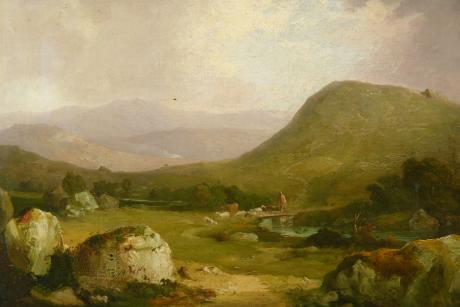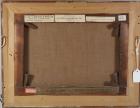inscribed on the stretcher "William Traies 1857 The First Bridge on the Dart Devon"
It is difficult to be precise in locating this view on Dartmoor. It could be one of many locations but two locations where Clapper Bridges can be found on Dartmoor are possibilities.
Dartmeet is a popular tourist spot in the centre of Dartmoor, Devon, England at grid reference SX672731.
It lies at the end of the B3357 road, about 4.5 miles (7.2 km) east of Two Bridges. From here, the road continues eastwards as a minor road with restrictions on the size of vehicles, past Poundsgate and over Holne Bridge and New Bridge to Ashburton on the edge of the moor. Immediately east of the river crossing, this road ascends Dartmeet Hill, a long steep hill that climbs 130 metres (430 ft) up the valley side. As the name suggests, Dartmeet is the meeting point of the two major tributaries of the River Dart: the East Dart and West Dart. The road bridge, built in 1792, spans the East Dart; just above it, at the side of the large carpark is an earlier, possibly medieval, clapper bridge, now partially collapsed. The actual confluence of the two rivers is just downstream of the bridge. Dartmeet is the official put in for the Upper Dart section of the River Dart for whitewater kayakers and canoeists.
Dartmeet is at the centre of an internationally important archaeological landscape mainly due to its prehistoric field systems, delineated by reaves, which are among the best preserved in north west Europe.
Dartmeet was one of the boundary points mentioned (though not by name) in the 1240 Perambulation of the Forest of Dartmoor, the boundary coming down the East Dart from the Wallabrook, and continuing up the West Dart to the foot of the O Brook. The first documentary reference to the name (as Dartameet) was in a Duchy of Cornwall document dated 1616. Halfway up Dartmeet Hill, close to the road, lies the Coffin Stone on which coffins would be placed to allow the bearers to take a rest on the way to taking bodies for burial at Widecombe-in-the-Moor. The rock is split in two, along its length. Local legend has it that the body of a particularly wicked man was laid there. God took exception to this, and struck the stone with a thunderbolt, destroying the coffin and splitting the stone in two.
Postbridge is a hamlet in the heart of Dartmoor in the English county of Devon. It lies on the B3212, roughly midway between Princetown and Moretonhampstead. Postbridge is on the East Dart river, one of two main tributaries of the River Dart, and consists of a few houses, a shop, a pub and hotel, and a national park tourist information centre. Postbridge is best known for its fine example of an ancient clapper bridge over the river. First recorded in the 14th century, the bridge is believed to have been built in the 13th century to enable pack horses to cross, carrying tin to the stannary town of Tavistock. The clapper bridge, a Grade II* listed structure, stands alongside a Grade II-listed bridge built in the 1780s.The settlement is also infamous for the ghost story of the Hairy Hands, which supposedly manifest themselves on a road near the village.
A clapper bridge is an ancient form of bridge found on the moors of the English West Country (Bodmin Moor, Dartmoor and Exmoor) and in other upland areas of the United KingdomIt is formed by large flat slabs of stone, often granite or schist. These can be supported on stone piers across rivers, or rest on the banks of streams. The slabs can be quite large. The ones at Postbridge (see image above) are over four metres long and each slab has a weight of over 8 tonnes. And others are tiny leading across small streams or leats (see below). The clapper bridges are mainly found on Dartmoor, where there are more than one hundred of them.
Although often credited with prehistoric origin, most were erected in medieval times, and some in later centuries. They are often situated close to a ford where carts could cross. According to the Dartmoor National Park, the word 'clapper' derives ultimately from an Anglo-Saxon word, cleaca, meaning 'bridging the stepping stones'; the Oxford English Dictionary gives the intermediate Medieval Latin form clapus, claperius, "of Gaulish origin", with an initial meaning of "a pile of stones". The word clapper derives from the Anglo-Saxon word cleaca, meaning “bridging the stepping stones”. This indicates that the first clapper bridges may have been formed of naturally occurring stepping stones, which were covered with flat slabs to make it easier to cross the river.

A fine example, the Postbridge Clapper Bridge, can be found at Postbridge, on Dartmoor. Its slabs are over 4 metres (13 ft) long, 2 metres (6 ft 7 in) wide and weigh over 8 metric tons (7.9 long tons; 8.8 short tons) each, making the bridge passable to a small cart. It was first recorded in 1380 and was built to facilitate the transportation of Dartmoor tin by pack horses to the stannary town of Tavistock.
Other surviving examples include the Tarr Steps over the River Barle in Exmoor, and Stara Bridge over the River Lynher in east Cornwall.Some larger clapper bridges, such as at Dartmeet and Bellever, have collapsed – their slabs swept away by floods, or raided for building or wall construction - and have since been rebuilt. However, there are many other smaller examples in existence on Dartmoor and still in use, such as those at Teignhead Farm (close to Grey Wethers stone circles), Scorhill and across the Wallabrook stream.
William Traies was born in Crediton, Devon in 1789. In his early years, he worked as a clerk at the Post Office in Exeter but spent much of his free time sketching with his friend and fellow artist John Gendall in the surrounding localities. He was also encouraged by Joseph Farington RA and became a landscape painter. One of his earliest successful artistic efforts was the illustrations he executed for a book on natural history written by a Scottish physician, Dr Neal. Through walking in the country and sketching Traies developed a great knowledge of the areas of Devon in which he lived and visited. His intimate knowledge of his landscape subjects resulted in art that was accurate, atmospheric, and evocative, leading to his securing several faithful patrons in Devon. He was known in that county and further afield as the Claude Lorraine of Devonshire .
Although the majority of his fame and recognition was specific to Devon and the surrounding counties Traies also made forays into the London art scene. He displayed four landscape works at the Royal Academy: one in 1817, two in 1822, and one in 1845. George Pycroft, in his book Art in Devonshire, writes of Traies thus, ‘he contrived to bathe his distances in the atmosphere and to get light and space in his skies in a way few artists could excel. His ravines and waterfalls in the Ruysdael style will always be valued, but there is a want of lightness and variety of tint in his foliage, which gives the heaviness to it which was the fault of the landscape painters of the age in which he lived. Traies had two sons, the second of which, Frank Traies, was also a painter predominantly known for depicting animal subjects. Frank Traies died early in life and, as such, never fulfilled his artistic potential. His death was an enduring sadness to his father. William Traies died at his residence in Exeter on 23r April 1872.
Traies was utterly devoted to art and painting the views of his home county, soon achieving such skill and reputation therein as to earn the sobriquet, ‘The Devonshire Claude’. He captured the lovely dells and rivers of Devon and there is a sensitiveness of the pellucid beauty of fine weather, fine skies, of noble foliage, and of untroubled humanity in his paintings. There was also a technical method that was almost perfect to the requirements of such scenes and to the painter’s intention.
Traies was a wonderful craftsman; his thin but creamy impasto and fine handling of varied greens, his limpid touch on running water, and the lucid cobalt of his summer skies will delight all who take pleasure in the mechanism of art.
He died on 28 April 1872 in Exeter.
Works in collections: Chequers Buckinghamshire; Exeter City Council; Inland Revenue; Victoria & Albert Museum; Plymouth City Museum & Art Gallery; Sheffield City Art Galleries; Torre Abbey, Devon; Watford Museum, Hertfordshire.
Bibliography:
Dictionary of British Landscape Painters – M.H. Grant
Victorian Painters – Christopher Wood



